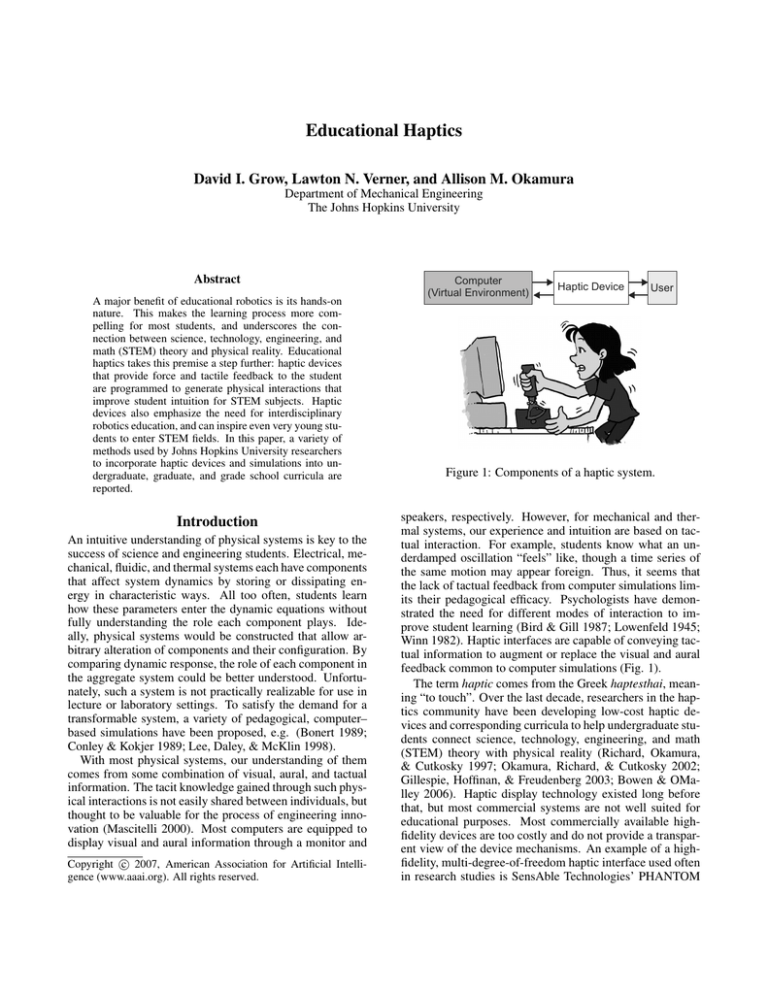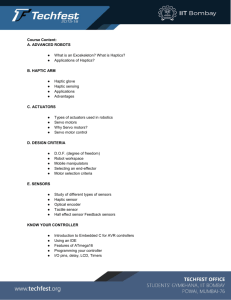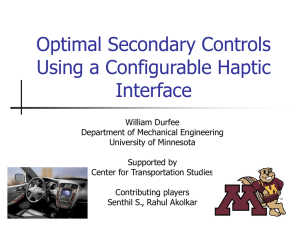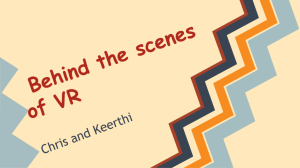
Educational Haptics
David I. Grow, Lawton N. Verner, and Allison M. Okamura
Department of Mechanical Engineering
The Johns Hopkins University
Abstract
A major benefit of educational robotics is its hands-on
nature. This makes the learning process more compelling for most students, and underscores the connection between science, technology, engineering, and
math (STEM) theory and physical reality. Educational
haptics takes this premise a step further: haptic devices
that provide force and tactile feedback to the student
are programmed to generate physical interactions that
improve student intuition for STEM subjects. Haptic
devices also emphasize the need for interdisciplinary
robotics education, and can inspire even very young students to enter STEM fields. In this paper, a variety of
methods used by Johns Hopkins University researchers
to incorporate haptic devices and simulations into undergraduate, graduate, and grade school curricula are
reported.
Introduction
An intuitive understanding of physical systems is key to the
success of science and engineering students. Electrical, mechanical, fluidic, and thermal systems each have components
that affect system dynamics by storing or dissipating energy in characteristic ways. All too often, students learn
how these parameters enter the dynamic equations without
fully understanding the role each component plays. Ideally, physical systems would be constructed that allow arbitrary alteration of components and their configuration. By
comparing dynamic response, the role of each component in
the aggregate system could be better understood. Unfortunately, such a system is not practically realizable for use in
lecture or laboratory settings. To satisfy the demand for a
transformable system, a variety of pedagogical, computer–
based simulations have been proposed, e.g. (Bonert 1989;
Conley & Kokjer 1989; Lee, Daley, & McKlin 1998).
With most physical systems, our understanding of them
comes from some combination of visual, aural, and tactual
information. The tacit knowledge gained through such physical interactions is not easily shared between individuals, but
thought to be valuable for the process of engineering innovation (Mascitelli 2000). Most computers are equipped to
display visual and aural information through a monitor and
c 2007, American Association for Artificial IntelliCopyright °
gence (www.aaai.org). All rights reserved.
Computer
(Virtual Environment)
Haptic Device
User
Figure 1: Components of a haptic system.
speakers, respectively. However, for mechanical and thermal systems, our experience and intuition are based on tactual interaction. For example, students know what an underdamped oscillation “feels” like, though a time series of
the same motion may appear foreign. Thus, it seems that
the lack of tactual feedback from computer simulations limits their pedagogical efficacy. Psychologists have demonstrated the need for different modes of interaction to improve student learning (Bird & Gill 1987; Lowenfeld 1945;
Winn 1982). Haptic interfaces are capable of conveying tactual information to augment or replace the visual and aural
feedback common to computer simulations (Fig. 1).
The term haptic comes from the Greek haptesthai, meaning “to touch”. Over the last decade, researchers in the haptics community have been developing low-cost haptic devices and corresponding curricula to help undergraduate students connect science, technology, engineering, and math
(STEM) theory with physical reality (Richard, Okamura,
& Cutkosky 1997; Okamura, Richard, & Cutkosky 2002;
Gillespie, Hoffinan, & Freudenberg 2003; Bowen & OMalley 2006). Haptic display technology existed long before
that, but most commercial systems are not well suited for
educational purposes. Most commercially available highfidelity devices are too costly and do not provide a transparent view of the device mechanisms. An example of a highfidelity, multi-degree-of-freedom haptic interface used often
in research studies is SensAble Technologies’ PHANTOM
(Massie & Salisbury 1994), which costs approximately US
$30,000. The most recent version of this device, the PHANTOM Omni, has lowered the cost of 3-degree-of-freedom
haptics to approximately US $2,400. In contrast, there exist
less expensive haptic displays for gaming, such as the Logitech Force 3D Pro, which retails for approximately US $70.
Although they have been used to provide physical intuition
in some undergraduate tutorials (Williams et al. 2004), these
systems do not have the fidelity or low-level control access
needed for many educational simulations. In this paper, we
describe our solution for low-cost, high-fidelity educational
haptics, discuss the pedagogical efficacy of classroom haptics, and illustrate a variety of educational applications.
Haptics in an Undergraduate Curriculum1
This section presents the application of haptics in an undergraduate dynamic systems course. To make haptic interfaces accessible to small groups of students in a large undergraduate course, the device must be low cost and relatively small. A rugged, single-axis force-feedback joystick called the haptic paddle (Fig. 2) can be assembled
for less than US $30 (assuming some surplus components)
and is controllable by a standard PC. The original design for
this interface at Stanford University involved third author
Okamura, Mark Cutkosky, Jesse Dorogusker, Christopher
Richard, Bart Nielson, David Hsu, and Brad Levin (Richard,
Okamura, & Cutkosky 1997). The primary differences between the haptic paddle and high-end haptic devices are degrees of freedom and power.
The operation of the device is simple. As a user takes
the handle of the haptic paddle and moves it from side
to side, the position of the handle is sensed. Based
upon the position and velocity of the handle, various
amounts of force are reflected back to the user. The
motor interfaces with the handle through a capstan (cable) drive. Device design and parts information, as well
as control code and curricula, are available to the public
at http://www.haptics.me.jhu.edu/research/paddle/. Haptic
paddle kits have been provided to over a dozen robotics
educators and researchers internationally. A future improvement to the haptic paddle is to provide a USB and/or
Firewire interface, in lieu of the parallel port and PCI cards
used previously.
To explore methods for integrating haptic education at the
undergraduate level, the curricula of junior-level dynamics
systems courses at Stanford University and Johns Hopkins
University were designed to make heavy use of the haptic
paddle. Because of the paddle’s low cost, students were are
able to assemble, model, identify, calibrate, and program
the device in small groups. Lab sessions held throughout
the semester revolve around the exploration of dynamic mechanical systems (Okamura, Richard, & Cutkosky 2002).
1
This concept was first proposed in (Richard, Okamura, &
Cutkosky 1997), and much of the text in this section is taken from
(Okamura, Richard, & Cutkosky 2002). The pedagogical efficacy
data is new.
Motor pulley
Handle
Motor
Sector pulley
Cable
Bushing
Magnet and
sensor
Base
Figure 2: The haptic paddle.
System modeling, identification, and calibration
In all dynamic systems courses, students learn to generate
the equations of motion governing first- and second-order
mechanical systems. As a laboratory tool, the haptic paddle
provides a cost-effective, high-fidelity example of a typical
second-order mechanical system upon which students can
experiment. In the haptic paddle laboratory sections, students develop models of the paddle system and calibrate the
system. They also obtain numerical values of parameters in
the model.
The dynamic model of the haptic paddle is similar to that
of the classic inverted pendulum. As an early objective of the
course, students are asked to derive the equation of motion
governing the paddle’s position using Newton’s law or an
equivalent method.
The derived equation includes parameters for equivalent
inertia, equivalent damping, and equivalent stiffness that
need to be identified. The paddle’s equivalent inertia is determined by combining the inertia of the sector pulley, measured using the bifilar pendulum method, and the reflected
inertia of the rotor, calculated using manufacturer specifications and the gear ratio. The equivalent damping of the
motor is identified through a least-squares fit of motor spindown data to an exponential decay objective-function. Because of the mechanical construction, Coulomb friction is
assumed to be negligible. The equivalent stiffness of the
system, which arises from its inverted-pendulum configuration, is calculated using the measured pulley center of mass
and some trigonometry.
angle (deg)
actual
ideal
time (s)
Figure 3: Homogeneous response of the haptic paddle with
proportional-derivative feedback control versus an ideal
second-order system.
Next, the motor torque output and position sensor must
be calibrated. Motor torque and speed constants are measured to estimate the maximum force the paddle can apply
(approximately 7.5 N). Assuming a linear motor model, the
students can then determine the transfer function for applied
voltage to force. The position sensor, a magnetic based Halleffect sensor, is calibrated by fitting a cubic polynomial to
the sigmoidal sensor output.
System response and feedback control
Connecting the device to a computer and using feedback
control shows that the haptic paddle allows student to fully
develop their fundamental understanding of STEM subjects.
By examining the equation of motion, students determine
the poles of the system. Since one of the poles has a positive
real part, the system is not stable. However, the system can
be stabilized through the addition of proportional-derivative
feedback control. The students calculate the equivalent
poles with feedback control and determine the values of the
feedback parameters kp and kd needed to satisfy stability
requirements. The haptic paddle is then connected to the
computer through an amplifier circuit. Control software is
designed that allows students to tune the the control gains
while they feel (holding the paddle handle and moving it
around), or see (deflecting the paddle and releasing it, or
adding a step input) the effect on system response.
The haptic paddle control software is also configured to
take several seconds of position, velocity, and input force
data. Students are asked to tune the feedback gains to make
the haptic paddle respond to a step input or initial condition
(the homogeneous response) like a classic, lightly damped
second-order system. From position data taken during the
response, students are asked to determine the corresponding
dimensionless damping parameter, ζ, and damped natural
frequency, wd . An ideal second-order system response is
then plotted over the actual haptic paddle data. The students
observe that the plots of actual data did not precisely match
those of an ideal second-order system due to Coulomb fric-
Figure 4: Virtual dynamic systems: (Top) Inverted pendulum with friction that can be manipulated by two cooperating paddles. (Bottom) Two-degree-of-freedom second order dynamic system whose model frequencies can be excited
through paddle motion.
tion (Fig. 3).
Using the paddle to explore virtual systems
The haptic paddle can also be used to interact with an unlimited number of ”virtual systems.” During the final stage
of the course, students are able to make their haptic paddle behave as if it is a virtual spring, or a virtual dashpot.
By adjusting the magnitudes of the virtual spring and damping constants, students can immediately feel the effects of
greater stiffness and greater damping. Moreover, by experimenting with negative values for the spring and damping
constants, students gain an immediate intuition of how such
values make a system unstable. Several more complex virtual environments are also designed and simulated which allow students to gain understanding of more complex systems by interacting with them via the haptic paddle. Figure 4 shows one that allows two paddles to interact with
an inverted pendulum and one that allows students to excite different modes of a multi-degree-of-freedom system.
In summary, the paddles allow students virtual interaction
with ideal, changeable physical systems.
Quantifying pedagogical efficacy
It is expected that hands-on laboratory sessions that incorporate haptic interfaces will improve both students’ tacit and
explicit knowledge of dynamic systems. A set of laboratory
sessions that feature the haptic paddle were designed and
refined during 2002 and 2003 at Johns Hopkins University.
To quantify the effectiveness of these labs, a study was performed during the following two years. Each semester the
dynamic systems class had two lab sections with roughly 20
students in each. There were five lab sessions during the
semester and each included a quiz either before or after the
hands-on exercises. One section would take the quiz before
Pre-lab quiz
Post-lab quiz
Quiz Score (%)
Figure 5: Quiz scores for select laboratory sessions using
the haptic paddle at Johns Hopkins University. Higher quiz
scores were associate with quizzes taken after performing a
haptics-based laboratory.
the lab and the other section took the quiz after, in alternating
order. Pre- and post-lab quiz results were later compared.
The study suggests that the lab exercises significantly improved student understanding of course material. On average, students quizzed after the lab scored 10% higher (M1
= 0.59, SD1 = 0.22, M2 = 0.64, SD2 = 0.20, p<0.05).
An even greater increase in performance was observed for
quizzes accompanying the third and fifth labs, which focused on tacit knowledge. Figure 5 illustrates the distribution of combined scores for these two labs. Quiz scores
among the post-lab group were over 20% higher than the
control (pre-lab) group (M1 = 0.49, SD1 = 0.26, M2 = 0.59,
SD2 = 0.21, p<.01).
Other indications also suggest that haptic education was
successful. Students were enthusiastic about having their
own high-performance electromechanical systems. Many
students personalized their paddles and even made small design modifications to improve performance. Once the kits
were assembled and connected to computers, many students
who had already been taught about resonant frequencies,
feedback, stability, etc. in the lectures were clearly surprised
at how small changes in feedback gains could have a profound effect on system behavior. As the students compared
their actual and ideal step responses and estimated the dimensionless damping and resonant frequency of their haptic
paddle, it was evident to the instructors that many of the students were fully understanding these concepts for the first
time.
Haptics in a Graduate Curriculum
Robotics is inherently an interdisciplinary research area, yet
it is rare to find robotics courses that mix programming,
experiments, design, artificial intelligence, and device mechanics/dynamics. The JHU graduate course “Haptic Systems for Teleoperation and Virtual Reality” was developed
specifically with an interdisciplinary audience in mind, including students from Biomedical Engineering, Computer
Science, Electrical Engineering, and Mechanical Engineering. The course project encourages teams with mixed backgrounds, as each major can impart essential knowledge to
the team. Biomedical engineers can provide background information on neuroscience needed for human psychophysi-
Figure 6: Students at the IEEE-RAS/IFRR School of
Robotics Science on Haptic Interaction assembled, programmed, and found creative uses for one-degree-offreedom haptic paddles.
cal studies and tissue models for surgical simulation. Computer scientists can emphasize real-time programming and
haptic rendering (analogous to graphics rendering). Electrical engineers are usually more experienced with control
design and systems and signals analysis. Finally, mechanical engineers provide needed expertise in hardware design
and dynamic modeling. Over the three years this course has
been taught, approximately 50% of course projects have resulted in refereed conference papers.
In September 2006, the IEEE-RAS/IFRR School of
Robotics Science on Haptic Interaction was held in Paris,
France (http://www.cim.mcgill.ca/˜haptic/summerschool/).
The robotics “summer school” series intends to provide a
high-quality, interdisciplinary, international education in a
chosen theme for each year. This occurs through interaction
with researchers in an informal classroom setting as well as
through joint student exercises and hands-on experiments.
At the summer school, students were allowed approximately
8 hours to develop and execute a hands-on haptics project,
which were then available for demonstrations at the end of
the school (Fig. 6). The authors brought 9 haptic paddles with associated computer boards and amplifiers, as well
as basic control code. Other researchers brought high-end
haptic devices, including Force Dimension’s Delta, MPB
Technologies’ Freedom 6S, Sensable’s PHANTOM Omni,
and Haption’s Virtuose 6D. Approximately half the project
teams used haptic paddles, and the other half used high-end
devices with existing C++ haptics libraries, such as CHAI
3D (http://www.chai3d.org/).
In the first four hours of the project, the haptic paddle
teams assembled and calibrated their devices, and demonstrated a basic level of functionality. For teams working on
virtual environments and low-level controls, this meant creating a simple virtual wall (a unilateral spring). For teams
doing teleoperation, they implemented a simple positionexchange bilateral controller. In the final four-hour period,
each team developed a more complex controller or demon-
strated a psychological/psychophysical phenomenon. Some
example controller projects include: (1) friction modeling
and compensation to improve device transparency, (2) teleoperation with position and force scaling, and (3) teleoperation with time delay. The psychological/psychophysical
projects included: (1) a haptic illusion in which lateral forces
convey bump “height”, (2) an experiment to determine human bump detection thresholds, and (3) an experiment in
which users were asked to “shake hands” with an imagined
person via the paddle in a manner determined by their emotions toward the imagined person (handshake motions were
recorded for later analysis and playback). The breadth and
sophistication of the projects was very impressive; this underscores the effectiveness of simple one-degree-of-freedom
high-fidelity haptic devices in encouraging interdisciplinary
education and innovation.
Haptics in K-12 Outreach
Haptic devices are excellent mechanisms for encouraging
excitement about engineering in K-12 students (Williams,
Chen, & Seaton 2003). Most children are familiar with haptics already, in the form of the “rumble pack”, which is a
hand-held video game controller that vibrates to reflect certain events in the virtual environment. But it is not until
they feel high-fidelity force feedback during simulations of
dynamic systems and 3-D shapes that they understand the
potential of haptics and gain knowledge about physical principles. Several haptic devices have been used to create a set
of demonstrations designed for elementary school students
and teachers. In Figure 7, a student uses a Immersion 3GM
haptic device to interact with a virtual ball. In another haptic demonstration, students are able bounce a ball while the
strength of gravity is varied. The students can feel what it
would be like to bounce a ball on Earth, the Moon, or Jupiter.
The key insight to be gained from this demo is that weight
is not the same as mass/inertia. The student can feel that the
inertia of the ball is unchanged when trying to accelerate it
using the paddle on all planets, but the ball’s motion in free
space is significantly affected by the gravitational constant.
Another way to use haptics in education is to bring the
devices into the public arena. An ideal mechanism for this
is a museum installation that uses haptics. There could be
many purposes for such an installation. In (Lazzari et al.
2001), haptic devices allowed patrons to “feel” works of art
that typically have a “do not touch” sign. However, the goal
of our work is to improve math, science and technology education, so the device to be created will display interesting
scientific or mathematical phenomena to the patron. Several museums contain modified scales that are programmed
to display the weight of patrons on various planets. It would
be much more compelling to allow patrons to feel what it
would be like to bounce a ball up and down under the effects
of gravity on different planets. Other systems could demonstrate electromagnetic systems, forces on a satellite orbiting
the moon (with a push button to apply jet forces), and manipulation of nanoparticles (Jones et al. 2003). To date, we
have redesigned the haptic paddle to create a larger, more
robust version. The Baltimore Museum of Science and Port
Discovery are local museums popular among young children
Figure 7: A haptics demonstration to middle school students
participating in a the Johns Hopkins University Robotics
Summer Camp.
and most likely to host the final display. Working with a curator, we plan to develop a final installation concept and find
a method to assess the effectiveness of such public haptic
displays. Metrics may include number of uses, time spent
per user, task execution in the virtual environment, or questions posed after the demonstration.
Conclusion
Methods for integrating haptic technology in various classroom settings have been described. We’ve shown how a simple, low-cost haptic device can be an effective teaching tool
for undergraduate education. Also, anecdotal evidence of
the impact of haptics in graduate education and K-12 outreach have been presented. Hopefully, this work will provide a foundation for the proliferation of haptics in a wide
variety of undergraduate course, graduate robotics courses,
K-12 demonstrations, and public spaces such as museums.
Acknowledgments
This work is supported in part by the Johns Hopkins University Kenan Teaching Fund and National Science Foundation
CAREER Award #IIS-0347464. We thank the other research
and teaching assistants at JHU who have worked on this
project (Jake Abbott, Dan Brzozowski, Masaya Kitagawa,
and Robert Webster), and Brent Gillespie, Marcia O’Malley,
and Hong Tan for useful discussions regarding educational
haptics. The IEEE-RAS/IFRR School of Robotics Science
on Haptic Interaction was organized by Vincent Hayward
and John Hollerbach. Jorge Cham provided Figure 1.
References
Bird, M., and Gill, G. 1987. Individual differences
and technology attributes: an examination of educational
technology considerations related to trade and industry
training. Australian Journal of Educational Technology
3(2):108–118.
Bonert, R. 1989. Interactive simulation of dynamic systems on a personal computer to support teaching. IEEE
Transactions on Power Systems 4(1):380–383.
Bowen, K., and OMalley, M. K. 2006. Adaptation of haptic interfaces for a labview-based system dynamics course.
14th Symposium on Haptic Interfaces for Virtual Environment and Teleoperator Systems 147–152.
Conley, E., and Kokjer, K. 1989. Classroom computers:
don’t forget the analog. Computers in Education Journal
9(3):30–31.
Gillespie, R. B.; Hoffinan, M. B.; and Freudenberg, J.
2003. Haptic interface for hands-on instruction in system dynamics and embedded control. 11th Symposium on
Haptic Interfaces for Virtual Environment and Teleoperator Systems 410–415.
Jones, G.; Bokinski, A.; Tretter, T.; Negishi, A.; Kubasko,
D.; Superfine, R.; and Taylor, R. M. 2003. Atomic
force microscopy with touch: Educational applications. In
Mendez-Vilas, A., ed., Science, Technology and Education
of Microscopy: An Overview.
Lazzari, M.; McLaughlin, M. L.; Jaskowiak, J.; Wing,
W. L.; and Akbarian, M. 2001. A Haptic Exhibition of Daguerreotype Cases of USC’s Fisher Gallery. In McLaughlin, M. L.; Hespanha, J. P.; and Sukhatme, G. S., eds.,
Touch in Virtual Environments. IMSC Press. 260–269.
Lee, K.-M.; Daley, W.; and McKlin, T. 1998. Interactive learning tool for dynamic systems and control. ASME
International Mechanical Engineering Congress and Exposition 64:71–76.
Lowenfeld, V. 1945. Tests for visual and haptical aptitudes.
American Journal of Psychology 58:100–112.
Mascitelli, R. 2000. From experience: Harnessing tacit
knowledge to achieve breakthrough innovation. Journal of
Product Innovation Management 17(3):179–193.
Massie, T., and Salisbury, J. K. 1994. The phantom haptic interface: A device for probing virtual objects. ASME
Winter Annual Meeting, Dynamic Systems and Control Division 55(1):295–300.
Okamura, A. M.; Richard, C.; and Cutkosky, M. R. 2002.
Feeling is believing: Using a force-feedback joystick to
teach dynamic systems. ASEE Journal of Engineering Education 91(3):345–349.
Richard, C.; Okamura, A. M.; and Cutkosky, M. R. 1997.
Getting a feel for dynamics: using haptic interface kits for
teaching dynamics and controls. American Society of Mechanical Engineers, Dynamic Systems and Control Division 61:153–157.
Williams, R. L.; He, X.; Franklin, T.; and Wang, S. 2004.
Haptics-augmented undergraduate engineering education.
International Conference on Engineering Education.
Williams, R. L.; Chen, M. Y.; and Seaton, J. M. 2003.
Haptics-augmented simple machines educational tools.
Journal of Science Education and Technology 12(1):16–27.
Winn, W. 1982. Visualization in learning an instruction:
a cognitive approach. Educational Communications and
Technology Journal 30(1):3–25.








